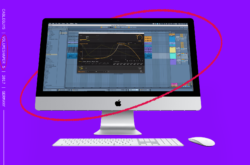Ableton Live is a complex software that can take years to fully master.
That said, sometimes the process is accelerated when you learn a neat trick or workflow. We recently gathered our top 50 tips and tricks for Ableton Live and packed them into a rapid-fire video—check it out below.
We’ve also transcribed the full list of tips below, with timecodes attached to each—navigate to those that are interesting to you in the video to see the techniques in action.
1. Drag stems while holding the shift key to separate them to individual tracks (0:35)
2. Save a default instance of your favorite plugin (0:39)
3. Freeze plugins to save CPU, and drag them while holding the option key to bounce audio (0:47)
4. Save your own custom templates (0:55)
5. Reverse 808s to create unique transitions (1:02)
6. Use Ableton’s Repitch Mode to make a scratch effect (1:11)
7. Use command + option + v to quickly open the video window (1:23)
8. Customize aesthetics including color gradient, hue, and skins (1:29)
9. Use the Bass Mono feature on the Utility device for 808s and basses (1:41)
10. Adjust velocity by dragging up or down on MIDI notes while holding the command key (1:48)
11. Skew automation shapes with automation flex points (1:53)
12. Right click a track title to assign a color to all of its clips (1:59)
13. Record arp patterns with an extra MIDI track (2:06)
14. Change the metronome sound to a sound of your choosing (2:22)
15. Right click on automation points to enter an exact value (2:29)
16. Transcribe chord progressions from a sample by using Convert Harmony to New MIDI Track (2:36)
17. Create interesting rhythmic effects by stretching a clip and playing with the Preserve value (2:45)
18. Hit z to zoom in on a selection, and x to quickly zoom out (2:58)
19. Ramp velocity values by dragging while holding the command key (3:04)
20. Use the MIDI stretch markers to get odd divisions like quintuplets (3:11)
21. Use sidechain gating to create some interesting chops (3:14)
22. Save a default track with your favorite plugins (3:22)
23. Map commands to your keyboard using command + k (3:34)
24. Increase the default MIDI velocity by hitting v, and decrease it by hitting c (3:46)
25. Save user presets to recall multiple instruments at once (3:55)
26. Use the Complex Pro warping algorithm to adjust the Formants setting on vocals (4:02)
27. Use Oversampling on EQ Eight to increase the audio quality (4:12)
28. Turn off the grid using command + 4 to achieve looser, humanized drum patterns (4:18)
29. Use the Fold function to omit notes that aren’t in your key in the MIDI window (4:26)
30. Extract and apply grooves on other audio clips by dropping them in the Groove Pool (4:40)
31. Record multiple takes by looping a region; previous takes will be saved on the lefthand side of the clip (4:53)
32. Delay tracks to push them slightly back in time (5:12)
33. Layer sounds in a drum rack by holding command + control (5:17)
34. Quickly toggle between Simpler and Sampler by right clicking the title of the device (5:26)
35. Double click the spectrum window to enlarge EQ Eight and Wavetable for more precision (5:34)
36. If your computer can handle it, set the Reverb device’s Global Quality to High and save it as the default (5:39)
37. Set up the Scale device after the Chord device to create chord progressions that solely use in-key pitches (5:48)
38. Keep plugin windows open when navigating between different tracks via Ableton’s Preferences (5:56)
39. Create individual stems by selecting the All Individual Tracks option when exporting (6:06)
40. Map multiple parameters to one knob using macros (6:14)
41. Delete segments of time by highlighting a region and hitting shift + command + delete (6:20)
42. Send multiple drum rack tracks to one audio effect by using the returns (6:25)
43. Use groups to process frozen tracks (6:36)
44. Use the audition mode in EQ Eight to isolate problematic areas (6:46)
45. Download free Max for Live devices (6:54)
46. Quickly audition presets by activating the Hot-Swap mode (7:06)
47. Use the M/S mode in EQ Eight and other devices for creative mixing and sound design (7:15)
48. Map your MIDI controls to your transport bar using command + m (7:23)
49. Hit command + h to quickly hide Ableton if you’re at work (7:32)
50. Read Ableton Live’s manual—it’s one of the best-written manuals out there and contains all the information you need to master the DAW
Do you have a favorite Ableton Live trick that we missed? Let us know in the comments below.
Explore royalty-free sounds from leading artists, producers, and sound designers:
October 10, 2019



